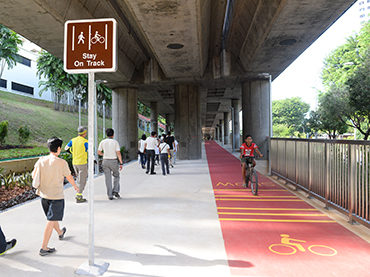Government Accepts Recommendations from the Active Mobility Advisory Panel on Regulations for Cargo Bicycles, Cargo Tricycles, Rider-only Tricycles and Recumbents on Paths and Roads
03 Mar 2023Press Releases
1. After studying the recommendations by the Active Mobility Advisory Panel (AMAP), the Ministry of Transport has accepted all the recommendations and will work with the various stakeholders to implement the new regulations for cargo bicycles, cargo tricycles, rider-only tricycles and recumbents on paths and roads.
2. The cycling community has expanded beyond users of conventional bicycles, to include users of active mobility devices such as cargo bicycles, cargo tricycles, rider-only tricycles and recumbents, particularly in European and North American cities. These devices are useful because they can be used by people with more specific needs. For example, recumbents can be used by those with mobility challenges or back conditions, and cargo and rider-only tricycles are also safer for seniors with issues balancing, as they provide more stability. However, in a highly built-up city-state like Singapore, we must also ensure that they can safely share spaces with existing users. In anticipation of the wider use of such devices in Singapore, and to ensure our rules are clear and consistent, AMAP had conducted a review of regulations on the usage of such devices in Singapore.
3. The Government thanks the AMAP for studying the issue and putting forth a set of recommendations that takes into consideration the perspectives of both path and road users, while ensuring that these devices are used safely and responsibly.
Standardised Criteria for Device Usage on Paths, and New Criteria for Device Usage on Roads
Device Usage on Paths
4. The Government recognises the need for consistency in device criteria, and agrees with the AMAP that non-motorised cargo bicycles, cargo tricycles, rider-only tricycles and recumbents should be subject to existing requirements for devices, i.e. ≤70cm in width and ≤20kg in unladen weight, when ridden on paths. This would better enable users of all active mobility devices to keep a safe distance when passing or overtaking each other on paths and reduce the risk of severe injuries in an accident.
Device Usage on Roads
5. As cargo bicycles, cargo tricycles, rider-only tricycles, and recumbents may come in larger sizes, making them less manoeuvrable, slower moving and more difficult to overtake on roads, the Government agrees with the AMAP’s recommendations to propose a new set of width and length requirements for device usage on roads.
6. In consultation with the Ministry of Home Affairs (MHA) and the Traffic Police (TP), we will subject all cargo bicycles, cargo tricycles, rider-only tricycles, and recumbents used on roads to the following new requirements: they must be a maximum of 1.3 metres in width and 2.6 metres in length. When formulating these width and length limits, we took into consideration the widest and longest active mobility devices already in use in Singapore. The 1.3-metre width limit takes reference from the width of a trishaw, while the 2.6-metre length limit takes reference from the length of a two-seater tandem bicycle. Overall, our approach is to ensure the safety of all road users, while facilitating the usage of active mobility devices.
7. For consistency, these new criteria will be extended to all active mobility devices that are permitted for use on roads, including conventional bicycles. These requirements would prevent the overall proliferation of overly wide or long devices on roads, which could potentially cause road congestion and safety risks.
8. To increase the visibility of recumbents to other road users, the Government also agrees with the AMAP’s recommendation for recumbents to be installed with a bright-coloured flag on a pole of a reasonable height. The Government will therefore introduce a rule for all recumbents to be installed with a bright-coloured flag that is affixed to a pole of a reasonable height, in addition to existing requirements for recumbents to have lights at night, such that the recumbents are at least as visible as regular bicycles when being used on the roads. This will enhance the safety of both recumbent users and motorists on roads.
Motorised Devices to Continue to be Disallowed on Paths and Roads
9. We accept the AMAP’s recommendation to continue disallowing motorised cargo bicycles, cargo tricycles, rider-only tricycles, and recumbents from paths and roads. The usage of uncertified motorised devices poses a fire risk and could compromise safety on paths and roads. The Government will review this again when recognised international standards are available.
Clearer Rules for Bicycle Trailers and Carrying of Passengers on Devices
Bicycle Trailers
10. We accept the AMAP’s recommendations for bicycle trailers to continue to be allowed on footpaths and cycling paths, provided they meet the existing criteria of
≤20kg in unladen weight and ≤70cm in width, inclusive of both the bicycle and the trailer.
11. Bicycle trailers, which are usually attached onto conventional bicycles, have a higher risk of tipping over when towed. This could potentially be hazardous to the user and other motorists when used on roads. We will thus also accept the AMAP’s recommendations to continue to disallow the towing of bicycle trailers by any type of active mobility device on roads.
Carrying of Passengers on Devices
12. The Government accepts the AMAP’s recommendation to allow all cargo bicycles, cargo tricycles and rider-only tricycles to carry passenger(s), provided they are equipped with a properly constructed seat or carrier (if the passenger is a child below 12 years of age), or a seat designed for passenger(s). This is in line with current rules for the carriage of passengers on conventional bicycles on paths and roads.
13. The Government will continue to raise awareness of the new rules through public education and outreach efforts. We encourage all active mobility users, pedestrians and motorists to continue to play their part by sharing paths and roads safely and graciously. We will continue to monitor developments in the active mobility landscape and ensure that our local regulations remain relevant and effective.
